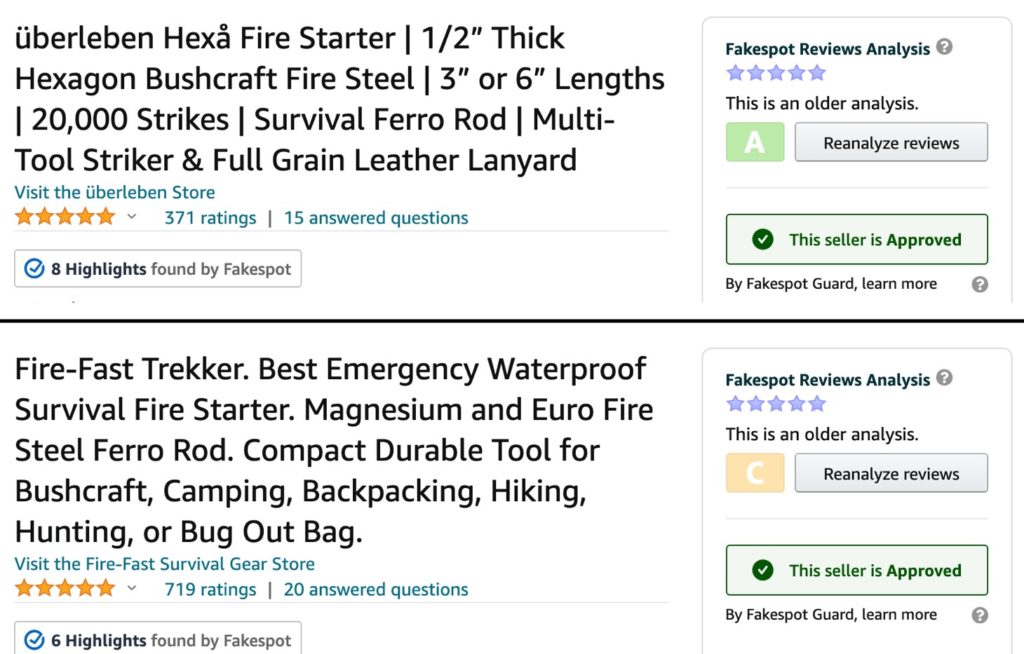As an editor at The Prepared, I’ve spent a lot of time over the past two years professionally shopping for gear on the internet. When we put together one of our in-depth reviews, we go through a lengthy process where we first put together a list of what’s popular in forums and other venues. Then we obsessively research those items in order to narrow that list down to a smaller group of products that we then buy and test.
So not only have I spent thousands of hours reading reviews and forum threads, but I’ve then closed the loop by actually getting my hands on hundreds of products to make a final verdict.
Based on that experience, I can offer some advice about how to shop online so that you get quality preps you can rely on in an emergency.
No single technique or formula will prevent you from blowing money on bad gear. You have to mix it up. The best you can do is reduce your odds of getting scammed by trying to shop smarter — you can never eliminate the possibility. The fact that you can only tweak the odds to be more in your favor is why it’s critical to test your gear before an emergency.
Fakespot and ReviewMeta
The first thing I do with Amazon products is check them using Fakespot. And for a second check, I’ll run them through ReviewMeta. I don’t do this in order to evaluate the product, but so that I can get a sense of whether or not the user ratings and reviews are worth looking through and considering.
Both of these services take in an ecommerce product page link (usually Amazon, but they support a few others, too) and analyze the reviews for signs of astroturfing. They then assign the product a letter grade, from A at the top through F at the bottom, based on how likely it is that many of the reviews are fake.
I also have a separate Chrome browser profile that I use for product research, where I have the Fakespot extension installed. This extension adds evaluations of both the product reviews and the Amazon seller to the Amazon page, itself. You can see these ratings for two different fire starting products in the picture, below:
Now, I picked these two specific screenshots for a reason: I’ve tested both products in our big fire steels review, and the A-rated Uberleben is complete junk (it literally does not work) from what appears to me to be a Chinese company masquerading as a European company, while the C-rated FireFast is a standout product from what I can confirm is a genuine USA maker.
So you just went on the Fakespot scores for these two products, you’d be making a big mistake. There are a few things going on here:
First, ReviewMeta and Fakespot are only evaluating the quality of the user reviews, not of the product itself. And apparently, the Uberleben user reviews are legit, while whoever it is that FireFast has hired to do their marketing is probably sending that money (with or without FireFast’s knowledge) to astroturfers who are posting fake reviews and wrecking their scores.
(Note: “astroturf” is a general term for any fake grass-roots effort, whether political or commercial. I’m using it in this article to refer to the process of planting fake user reviews online.)
Then there’s the fact that most of the people reviewing most products are bad and unreliable reviewers. As of this writing, 62 percent of the 408 Uberleben striker reviews were five-star, which tells me that there are 252 people who apparently bought this item for weird hipster reasons — probably they wear it around Brooklyn on their way to their taxidermy class — and aren’t actually trying to use it. Either that or Uberleben has hired a superior class of astroturfers, which is also very much a possibility.
The scenario where the product with the bad Fakespot grade has beat the pants off the product with the A grade has happened enough times in our reviews, that I strongly discourage anyone from taking such grades as in any way connected to the quality of the product itself. These grades are only useful as inputs into the second part of the process, which is where you evaluate the actual ratings and reviews.
Ecommerce reviews
When I move from the FakeSpot score to the user reviews, the first thing I do is check the one- and two-star reviews. I’m often far more interested in why people were unhappy with a product than I am in why they loved it, and the low-star-count reviews are the place to get that information. But there are a few major caveats with this approach that need to be kept in mind.
First, sellers not only pay astroturf companies for positive reviews, but they pay for negative reviews of competing products. So if you see a particularly detailed negative review, then go back through that user’s other reviews and check to see if they look legit.
An even bigger problem is that users sometimes get a fake version of the product from an unscrupulous seller, and the resulting reviews are actually for the fake.
A recent example that comes to mind is when I did a bunch of shopping for aftermarket water repellent sprays (DWR) for clothing and other gear. A number of one-star reviews of DWR products from completely different makers and sellers all complained about the same thing — the product they got was just a chalky white substance that was difficult to get out of the can or bottle and didn’t appear to do anything. It was clear that some manufacturer, probably in China, was producing fakes of this entire category of products, and that these users were getting those knock-offs instead of the genuine article.
There are a few online shopping tricks that people think work, but they actually do not.
This is also a big problem with knives, multitools, and other tools. Sometimes a product will have very strong reviews, but the one-stars all indicate that it broke quickly and is total junk. Again, the users whose products broke right out of the box probably got cheap knock-offs.
In cases like my DWR sprays example, it was easy to tell that the people complaining about a bottle filled with a white chalky substance had gotten fakes. But with knives, some makers really do have quality control problems with some of their product lines, so it’s not guaranteed that there really aren’t some number of legitimate lemons that account for the negative reviews.
When possible, I’ll go check out the reviews on a specialty ecommece site and look for similar reported problems. For knives, that means heading over the BladeHQ, Knifecenter, and similar outlets. These smaller vendors get their products directly from the maker, so you’re not dealing with Amazon warehouse problems.
Note: Fakes aren’t always bad, or even really fake. There are instances where the “fake” version of a product comes off the exact same manufacturing line as the original article because the unscrupulous manufacturer is secretly running an extra shift and then offloading the output onto the gray market without the vendor’s knowledge. If you accidentally score one such item at a big discount, obviously you won’t know the difference.
Forums
Threads in niche forums are a great source of intel on which products are good and which are junk. Back when I was doing more writing in the outdoors space, my main exposure to prepper forums was through scrolling them to find product reviews and recommendations.
But as with all the rest of the tips in this article, you have to be careful. Vendors are as aware as anyone that user reviews in niche forums carry a lot of authority, so they game them viciously. It’s very cheap to hire gray-market astroturf firms to set up and maintain forum personas, and then drop plugs for products.
And yes, it’s that serious — these firms hire people to spend their days running multiple sock puppet accounts on target forums, getting into fights and arguments, offering tips and advice, wishing other users happy birthday, posting photos of their pets, or whatever else, just so that the paid reviews they sprinkle into their output will smell legit to the community and to any users who happen on them via Google. So just because you found a niche forum discussion of a product, with a handful of users weighing in to affirm that it’s great, that doesn’t mean any of the posts are genuine.
It’s also the case that any halfway decent astroturfer will take care to optimize their fake review for SEO, which often means that a high Google ranking for a forum review link is often a reason to be wary of it. I actually trust the reviews on the deeper pages of the Google results more than I do the ones on the first page or so, for this reason.
As you evaluate forum reviews, you should take it to the next level by looking through the user’s other posts and seeing how legit they smell to you. This won’t guarantee that you’ll catch an astroturfer, but you’ll at the very least be able to weed out the lazy ones who aren’t trying hard enough. If a poster regularly drops plugs for certain products and doesn’t also express negative opinions of competitors, then that’s a giveaway. People who express real positive opinions in favor of product X also tend to express real negative opinions against competitor Y, whereas astroturfers just see their job as shilling product X so they stop there.
Finally, all of the above definitely applies to Reddit. For purposes of product research, you should treat a subreddit is just like any other niche forum you’d find on the internet. Go back and vet the profiles of users who are talking up a product, and see if they’re also talking down competitors, and if they strike you as genuine.
Buying directly from the vendor on Amazon doesn’t help
There are a few online shopping tricks that people think work, but they actually do not. The main one is buying a product directly from the vendor on Amazon (e.g. buying a pair of Crocs from the official “Crocs” Amazon seller account), in hopes of avoiding fakes. Sometimes the official vendor is accidentally selling some number of fakes — the reason comes down to what Amazon calls “commingling” of inventory.
Here’s a blog post with a really good, succinct description of the problem:
It works like this: Amazon has a single listing on its marketplace for each unique item. Different vendors may sell the same product, which all use this shared listing.
However, these products are not simply lumped together on the website. In fact, the items from each seller using Fulfilled By Amazon (FBA) are stored together physically in commingled containers.
So, a customer goes to Amazon and places an order through one store. But when the actual item is taken to be shipped to the customer, it could be picked from inventory provided by anyone also selling the product.
So if nine vendors are each selling an authentic product, and one vendor is selling a counterfeit version of that product, then all ten of them will suffer the consequences if the counterfeiter is not stopped. Even Amazon has troubled determining where the product came from, once the customer sends it back.
Sellers commingle inventory like this because Amazon strongly incentivizes them to. Another blog post on commingling puts it this way:
Non-commingled FBA inventory proves to be a good alternative to commingling when the goods you sell are highly predisposed to fraud. It is also a good option if you are confident of your fulfillment capabilities and the cost-effectiveness of your inventory. Otherwise, the time and money saved by going stickerless is a strong incentive for commingling. Commingling can also grease the wheels for getting orders fulfilled lightning-fast, which Amazon and its customers really love.
There is no way for you, as a buyer, to know if a vendor is cutting corners by using commingling. This means that buying “directly” from the vendor’s seller account is not a sure-fire solution for avoiding fakes. It may not even cut down on the likelihood that you’ll get a fake by any meaningful amount.
The “Verified Purchaser” cannot be trusted
The other trick that doesn’t work is looking for the “Verified Purchaser” tag on a user review. There are two main ways vendors game the “Verified Purchaser” badge:
- Paying users to buy products
- Brushing
The first trick is where the vendor pays a user through a backchannel — usually PayPal or an Amazon gift card — to purchase a product under their own account, so that they can review it and get a “Verified Purchaser” tag. This is actually legal if the user discloses that the product was paid for by the vendor, and some users do. But often enough, there’s no disclosure.
The second scam is called “brushing,” and it’s a low-grade form of identity theft. An unscrupulous marketer finds someone’s name and address online, sets up a fake Amazon account for that person, and then buys stuff and sends it to them so the marketer can post fake “verified” reviews under their name. The users whose identity is stolen get random free stuff in the mail, which may sound nice but the price is that scammers are exploiting your name.
If you want the real thing, be prepared to pay extra
When I shop online, I’m always making a risk/reward calculation around how important it is for me to not get a fake of a particular product. For some products, I’m ok taking a lot of risk that I’m getting a fake. But when it comes to my preps, most of the time I go the extra mile by using the steps above to decrease my odds of getting scammed.
And for some preps, where I know that the number of fakes is high and I’m very concerned about getting the real deal — SureFire flashlights are a prime example of this for me — I just buy directly from the manufacturer’s website. This means I’m going to pay full price plus shipping, but it’s worth it to me because I know I’m guaranteed to get the genuine article. Everyone has to decide where that line is for themselves, based on their own budget and needs.



You are reporting the comment """ by on